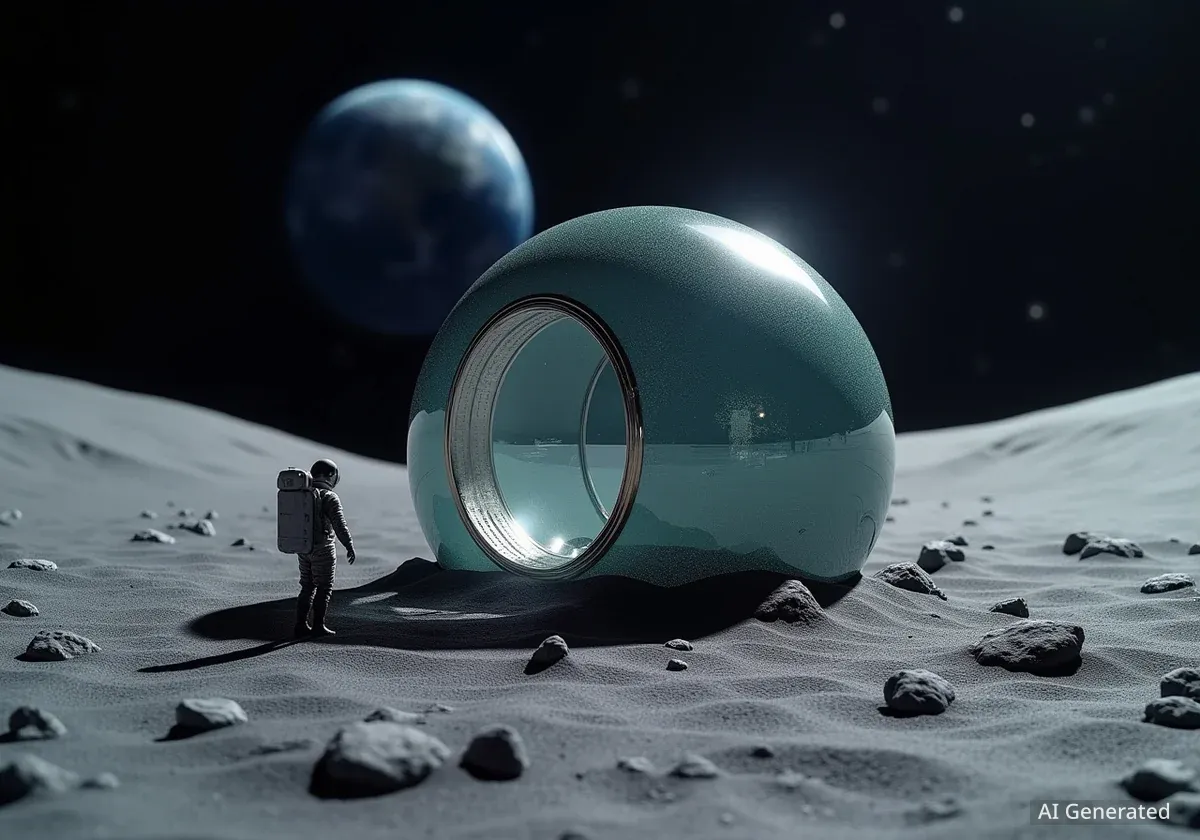NASA is supporting the development of a new type of lunar habitat made from giant glass spheres. The concept, created by California-based company Skyeports, involves melting Moon dust and blowing it into large, transparent structures that could one day house astronauts.
This project is part of NASA's Innovative Advanced Concepts (NIAC) program, which funds forward-thinking ideas for future space exploration. The goal is to use local lunar resources to overcome the high cost of transporting building materials from Earth.
Key Takeaways
- NASA is funding Skyeports to develop habitats made from lunar dust, also known as regolith.
- The process involves melting regolith in a furnace and blowing the molten material into large glass spheres.
- These transparent habitats could potentially be hundreds of meters in diameter and support self-sustaining ecosystems.
- The project aims to lower construction costs for long-term lunar missions under the Artemis program.
A New Approach to Lunar Construction
Building structures on the Moon presents a significant logistical challenge. The cost of launching materials from Earth is extremely high, making large-scale construction impractical with current methods. To address this, NASA is exploring in-situ resource utilization (ISRU), which focuses on using materials already present on the lunar surface.
The concept from Skyeports leverages the composition of lunar regolith, which can be up to 60% silicates, the primary component of glass. The plan involves sending a microwave furnace to the Moon, which would be fed with mined regolith. Once melted, the molten glass would be extruded and inflated into a large sphere using gas pipes.
After the glass hardens, the pipes used for inflation would be repurposed as an entrance. The interior fittings and furnishings would then be 3D-printed using other processed lunar materials, further reducing the need for Earth-based supplies.
The Challenge of Building in Space
Every kilogram of mass launched into space has a substantial cost, often running into thousands of dollars. By developing technologies that can utilize local resources like lunar dust, space agencies can significantly reduce the mass and cost of future missions, enabling more ambitious and sustainable exploration.
The Science Behind Glass Habitats
While glass is often considered brittle on Earth, its properties can be significantly enhanced for space applications. Dr. Martin Bermudez, the CEO of Skyeports, explained that the material can be adapted to become stronger than steel by integrating metals like titanium, magnesium, and calcium into the glass mixture during the melting process.
"I was originally told ‘well glass is too brittle, it’s gonna break’ so I started reaching out to scientists and realised it can be adapted and become something stronger than steel," Dr. Bermudez stated.
The spherical shape is a natural outcome of the manufacturing process in low gravity and is also structurally efficient. A sphere evenly distributes pressure, making it an ideal shape for a pressurized habitat. The concept also includes the possibility of using self-healing glass to automatically seal small cracks or dents caused by micrometeorites.
From Small Prototypes to Large Domes
Skyeports has already demonstrated the feasibility of the concept by creating small glass spheres, just a few inches wide, in a laboratory setting. The long-term vision is far more ambitious, with the potential for habitats measuring between 300 to 500 meters in diameter.
"The spherical shape happens automatically, because at that temperature it becomes an amorphous liquid, and when it is extruded out of a furnace in low gravity it will form the shape of a sphere," Dr. Bermudez added.
Project Development Timeline
- January 2026: Initial tests of the blowing technique in a thermal vacuum chamber.
- Following Phase: Trials on parabolic flights to simulate micro-gravity conditions.
- Future Steps: Potential experiments aboard the International Space Station (ISS).
- Long-Term Goal: On-site tests on the lunar surface within the next few years.
A Vision for a Self-Sustaining Lunar City
The transparent nature of the glass domes offers more than just a view; it is a key element for the well-being of astronauts on long-duration missions. Natural light and the ability to see the lunar landscape and even Earth could provide significant psychological benefits.
"Mental health is going to be important on long-duration missions and it will be important for astronauts to be able to see outside, and perhaps even see the Earth," explained Dr. Bermudez.
Beyond living quarters, these habitats could become self-sustaining ecosystems. By creating layered bubbles, temperature differences between surfaces could cause condensation, providing a source of water for growing plants. This would create an internal ecosystem that produces oxygen and food for the inhabitants.
The design also incorporates energy generation. Solar panels could be embedded directly into the glass shell, allowing the entire structure to function as a massive power generator. Dr. Bermudez envisions a future with interconnected glass communities on the Moon.
"I would love to see whole communities of these, a city of them, housing parks, water systems and homes, all connected through glass bridges. You will never replicate Earth, but this is something that gets pretty close," he said.
Supporting Future Exploration
This project is funded through NASA's NIAC program, which is designed to support early-stage concepts that could radically change future missions. The development of sustainable habitats is critical for NASA's Artemis program, which aims to establish a long-term human presence on the Moon.
Clayton Turner, associate administrator for NASA’s Space Technology Mission Directorate, highlighted the importance of such innovative ideas. "Our next steps and giant leaps rely on innovation, and the concepts born from NIAC can radically change how we explore deep space," he said.
As the Artemis program progresses, technologies that enable astronauts to live and work on the Moon for extended periods will be essential. Concepts like the Skyeports glass habitats represent a potential pathway to making humanity a multi-planetary species.





